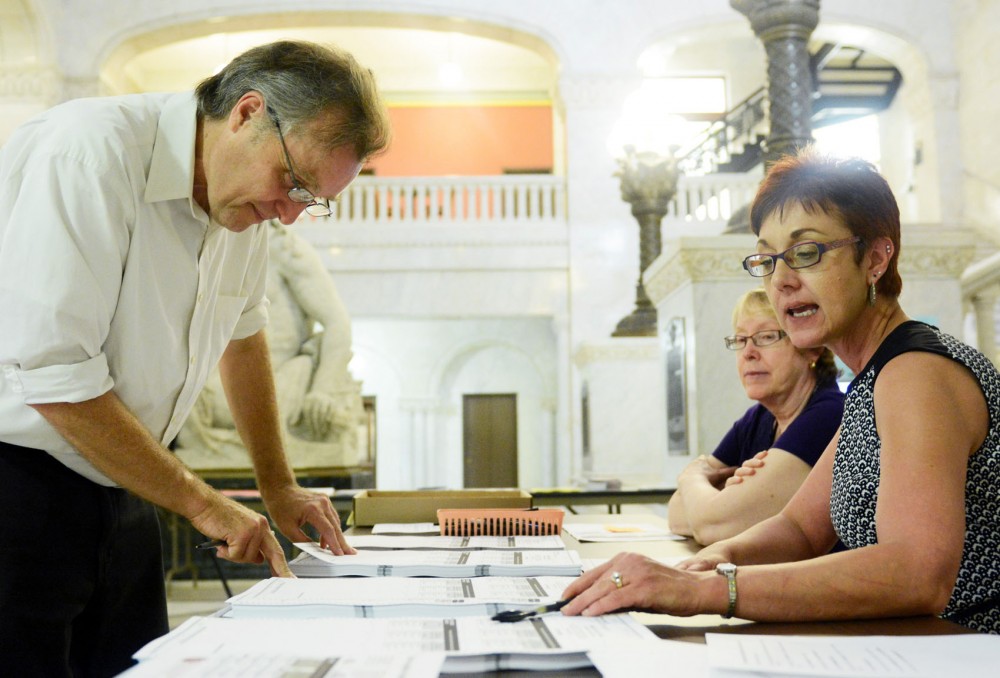Minneapolis will test a ranked-choice voting system this election year – a balloting method used by less than 20 cities nationwide.
Proponents of ranked-choice voting say it will lead to more candidates being considered, but others say the system still has flaws.
Minneapolis leaders held a mock election Friday to educate voters, test the new machines and make sure city workers understand the new system, said City Clerk Casey Carl.
“It’s a dress rehearsal for us as well,” he said.
The mock election will be rolled out in five different locations over the next week, to allow Minneapolis residents to practice ranked-choice voting. This will be the second election with instant runoff voting, but the first with new polling equipment.
Minneapolis’ system allows voters to rank up to three candidates, all of whom are listed on the ballot under columns, for first, second and third choice.
If there isn’t a majority on the first vote count, the least popular candidate is eliminated and ballots listing the eliminated candidate as their top choice become votes for candidates listed in those ballots’
second spots.
Votes are recounted and the process repeats until a candidate reaches a majority.
The old voting system allowed only two candidates with the most votes to move forward in the election, said Ward 2
Councilman Cam Gordon, and implementing rank-choice voting eliminates the mayoral primary.
Gordon said voters are more likely to choose an underdog as their first choice in the ranked-choice system because if that candidate loses, their vote still hasn’t been lost.
The Minnesota Public Interest Research Group at the University of Minnesota also supports the system.“It is a really great opportunity to reflect the opinions of the voter,” said MPIRG co-chair Kate Dobson.
But Anna Breen, president of the University’s Democracy Matters student group, said ranking three candidates on the ballot means voters need to know triple the amount of information to make an informed decision.
Breen said for ranked-choice voting to be successful in Minneapolis, there needs to be a push for voter education and preparation.
This year’s mayoral race includes 35 candidates, making the process more complex than when it was first implemented four years ago.
“Ranked-choice is an idealistic and positive development, but the system has to work properly,” said mayoral front-runner and former Hennepin County Commissioner Mark Andrew.
Captain Jack Sparrow, a political activist and candidate in this year’s mayoral race, is focusing his campaign on ranked-choice voting reform.
Sparrow said he’s running on a “rank all choices” platform to raise awareness about the ranked-choice system’s shortcomings.
Mayoral candidate Bob “Again” Carney, Jr. also supports a system where voters rank every candidate and is critical of ranked choice.
“With three rankings, you can waste your vote three times,” he said.
Gordon said the ranked-choice system encourages candidates to avoid “attacking” each other because they want to appeal to voters who might also support their opponents.
“[They] know that they might not win with first choices and they’re going to need some second or third choices to win,” Gordon said.
Every candidate has to win over all the voters rather than just those who agree with his or her platforms, mayoral candidate Cam Winton said, so the process could create more civility among competitors this year.
“People are still figuring out how it works,” Winton said.
Mayoral candidate Dan Cohen said Minneapolis could serve as an example of ranked-choice voting on a large scale, and depending on the election’s success, other cities might
follow suit.
“This way you’re going to hear from people of widely diverse backgrounds and viewpoints, and I think that’s a benefit to the public,” mayoral candidate Dan Cohen said.








